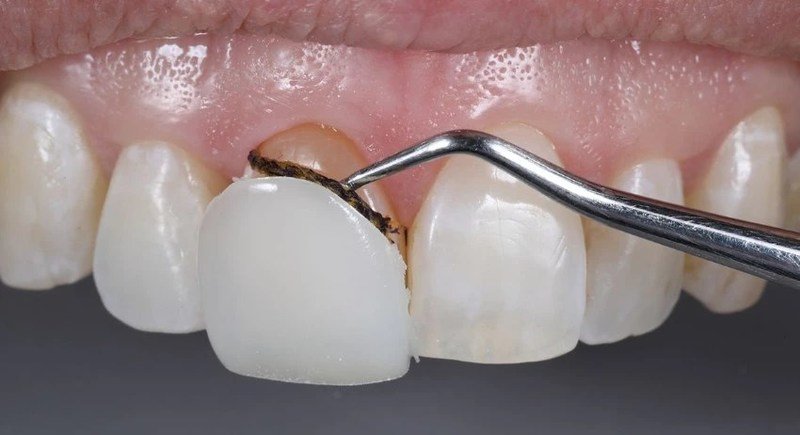
Are you wondering if dental veneers can be removed? Well, let me put your mind at ease. Dental veneers, those thin shells of porcelain or composite resin that are bonded to the front of your teeth, can indeed be removed. But before we dive into the details, let’s explore why someone might consider removing dental veneers in the first place.
Picture this: you’ve had dental veneers for a while, and maybe you’re not as satisfied with the results as you initially thought you would be. Or perhaps your veneers have become damaged or discolored over time. Whatever the reason, you’re now wondering if it’s possible to reverse the process. And the good news is, it is! Dental veneers can be removed, allowing you to explore other options or start fresh with a new set of veneers. So, let’s delve into the world of dental veneer removal and discover what you need to know.
Can Dental Veneers Be Removed?
Dental veneers are a popular cosmetic dental treatment, but can they be removed? The answer is yes, dental veneers can be removed; however, the process can be complex and may require some adjustments to your natural teeth. It is crucial to consult with a qualified dentist who can guide you through the removal process and discuss alternative options if needed. Remember, dental veneers are designed to be a long-term solution, so removal should be carefully considered.

Can Dental Veneers Be Removed?
Dental veneers are a popular cosmetic dental treatment that can transform the appearance of your smile. They are thin shells made of porcelain or composite resin that are bonded to the front surface of your teeth. Veneers can correct a variety of dental issues, such as discoloration, chips, gaps, and misalignment. However, if you are considering getting veneers, you may be wondering if they can be removed in the future if you change your mind or if there are any complications. In this article, we will explore the question, “Can dental veneers be removed?” and provide you with all the information you need to know before making a decision.
The Process of Getting Dental Veneers
1. Consultation:
- Discuss goals and expectations for your smile with your dentist.
2. Tooth Preparation:
- Your dentist removes a small amount of enamel from the front surface to ensure a proper fit.
3. Impression and Customization:
- An impression of your teeth is taken to create custom-made veneers tailored to your unique smile.
- Temporary veneers may be placed to protect your teeth during the fabrication of permanent veneers.
4. Bonding Process:
- Once permanent veneers are ready, your dentist bonds them to your teeth using dental adhesive.
- Results in a beautiful, natural-looking smile that can last for years with proper care.
Are Dental Veneers Permanent?
– Longevity:
- While designed to be long-lasting, dental veneers are not considered permanent.
- May need replacement due to wear, changes in oral health, or for aesthetic reasons.
– Enamel Removal:
- Removal of a small amount of enamel during the preparation process is permanent.
Can Dental Veneers Be Removed?
– Removal Process:
- Dental veneers can be removed but require professional expertise due to the strong adhesive.
- The process involves carefully grinding away veneers to preserve the underlying tooth structure.
– Precision and Sensitivity:
- Precision is crucial to avoiding damage to natural teeth.
- Teeth may be sensitive after removal, requiring temporary protection until a new treatment plan is established.
Considerations Before Removal
– Professional Consultation:
- Consult with your dentist before considering veneer removal.
- Individual assessment of the best course of action based on specific needs and concerns
– Irreversible Nature:
- Removal is irreversible, and a plan must be in place for the appearance and function of teeth post-removal.
Reasons for Removing Dental Veneers
There are several reasons why someone may choose to have their dental veneers removed. These can include:
1. Desire for a different aesthetic: Over time, your preferences or style may change, and you may want to explore other options for improving your smile.
2. Veneer damage or wear: Veneers can become damaged or worn down due to factors such as teeth grinding, trauma, or poor oral hygiene. In these cases, removing and replacing the veneers may be necessary.
3. Poor fit or discomfort: If your veneers are ill-fitting or causing discomfort, your dentist may recommend their removal to address the issue and provide a better solution.
4. Changes in oral health: In some cases, changes in your oral health, such as gum disease or decay, may require the removal of veneers to address the underlying issues.
5. Veneer lifespan: While veneers can last for many years, they are not permanent. If your veneers have reached the end of their lifespan, your dentist may recommend their removal and replacement.
It is essential to have a thorough consultation with your dentist to discuss your specific concerns and determine the best course of action if you are considering removing your dental veneers.
Alternatives to Veneer Removal
If you are unhappy with your dental veneers but do not wish to have them removed, there may be alternative solutions to address your concerns. These can include:
1. Veneer repair: If your veneers are damaged or worn, your dentist may be able to repair them rather than removing and replacing them entirely.
2. Veneer modification: If you are dissatisfied with the appearance of your veneers, your dentist may be able to make modifications to improve their aesthetic without removing them.
3. Dental bonding: Dental bonding is a less invasive alternative to veneers that can address certain cosmetic concerns. It involves applying a tooth-colored resin material to the teeth to improve their appearance.
4. Orthodontic treatment: If misalignment or spacing issues are the primary concern, orthodontic treatment such as braces or clear aligners may be a more appropriate solution.
It is crucial to consult with your dentist to discuss all available options and determine the best course of action based on your individual needs and goals.
Conclusion
In conclusion, dental veneers can be removed, but the process requires the expertise of a dentist and is irreversible. While veneers are designed to be long-lasting, they are not considered permanent, and there may be instances where removal is necessary or desired. If you are considering removing your dental veneers, it is important to consult with your dentist to discuss your concerns, explore alternative solutions, and develop a customized treatment plan. Remember, the decision to remove dental veneers should be made in collaboration with your dental professional to ensure the best outcome for your oral health and smile aesthetics.
Key Takeaways: Can Dental Veneers Be Removed?
- Yes, dental veneers can be removed, but it’s a complex and irreversible process.
- Removing veneers may require grinding down the outer layer of the teeth.
- Removing veneers can leave the teeth vulnerable to sensitivity and damage.
- It’s important to consult with a dentist before considering veneer removal.
- Regular dental care and maintenance can help extend the lifespan of veneers.
Frequently Asked Questions
1. Can dental veneers be removed?
Yes, dental veneers can be removed, but it is not a simple process. The removal of veneers requires the expertise of a dental professional. The veneers are bonded to the natural teeth using a strong adhesive, so removing them without causing damage to the teeth can be challenging.
The dentist will carefully evaluate the condition of the veneers and the underlying teeth before deciding on the best approach for removal. In some cases, the veneers may be gently pried off using specialized tools. In other cases, the dentist may need to use a dental drill to carefully remove the veneers layer by layer.
2. Are there any risks or side effects associated with removing dental veneers?
While the removal of dental veneers is generally safe, there are some risks and side effects to consider. The removal process can cause some discomfort or sensitivity, especially if the veneers have been in place for a long time. The adhesive used to bond the veneers may also leave behind a residue on the teeth, which can be challenging to remove.
In some cases, the removal process may cause minor damage to the natural teeth, such as small chips or cracks. However, these issues can usually be addressed with dental bonding or other cosmetic procedures. It is essential to choose a skilled and experienced dentist who can minimize the risks and ensure a successful removal process.
3. Why would someone want to have dental veneers removed?
There are several reasons why someone may want to have their dental veneers removed. One common reason is that the veneers have become worn or damaged over time and are no longer providing the desired aesthetic results. Another reason may be that the individual wants to explore alternative cosmetic dental treatments.
In some cases, the underlying natural teeth may have changed, such as shifting or discoloration, which may require the removal of the veneers for appropriate treatment. Additionally, if there are any issues with the veneers, such as recurrent decay or gum problems, the dentist may recommend their removal to address these concerns.
4. Can dental veneers be replaced after removal?
Yes, dental veneers can be replaced after removal. Once the veneers are removed, the dentist will assess the condition of the natural teeth and discuss the patient’s goals and preferences. If the underlying teeth are healthy and suitable for veneers, new veneers can be created and bonded to the teeth.
The replacement process typically involves taking new impressions of the teeth and working with a dental laboratory to create custom-made veneers that match the patient’s desired appearance. The dentist will then bond the new veneers to the teeth, creating a refreshed and natural-looking smile.
5. How long do dental veneers typically last?
Dental veneers can last for many years with proper care and maintenance. On average, veneers can last between 10 to 15 years, but their lifespan can vary depending on various factors, such as oral hygiene practices, diet, and habits like teeth grinding or clenching.
Regular dental check-ups and cleanings are essential to monitor the condition of the veneers and ensure their longevity. It is also important to follow the dentist’s instructions for oral hygiene and avoid habits that can put excessive stress on the veneers. If any issues arise, such as chips or cracks, it is crucial to seek prompt dental care to address them and prevent further damage.
Replacing old porcelain dental veneers before and after
Final Summary: Can Dental Veneers Be Removed?
Dental veneers, though transformative, are not permanent fixtures. They can be safely removed by a dental professional when desired. The removal process involves carefully separating the veneer from the tooth using specialized instruments, ensuring minimal discomfort and preserving tooth structure. Once removed, natural teeth are visible again. It’s crucial to seek assistance from a qualified dentist for safe and effective removal, balancing aesthetic enhancement with natural tooth health. So, while veneers offer smile improvement, remember their temporary nature and the importance of professional care when considering removal.
Call or Book appointment online
:Ace Dental Care Alpharetta office: 678-562-1555 - Book Now
Ace Dental Care Norcross office: 770-806-1255 - Book Now
Disclaimer
This blog post was generated by artificial intelligence. The content of this post may not be accurate or complete, and should not be relied upon as a substitute for professional advice. If you have any questions about the content of this post, please contact us.
We are constantly working to improve the accuracy and quality of our AI-generated content. However, there may still be errors or inaccuracies. We apologize for any inconvenience this may cause.





